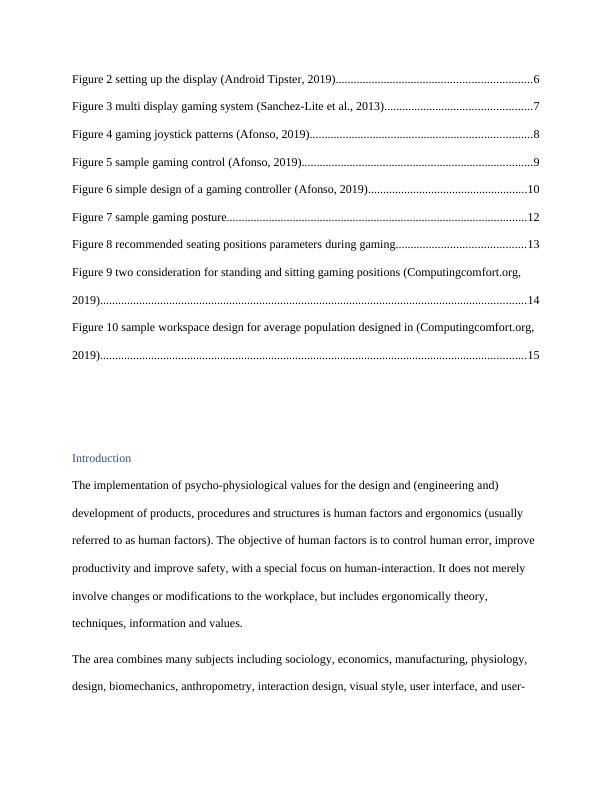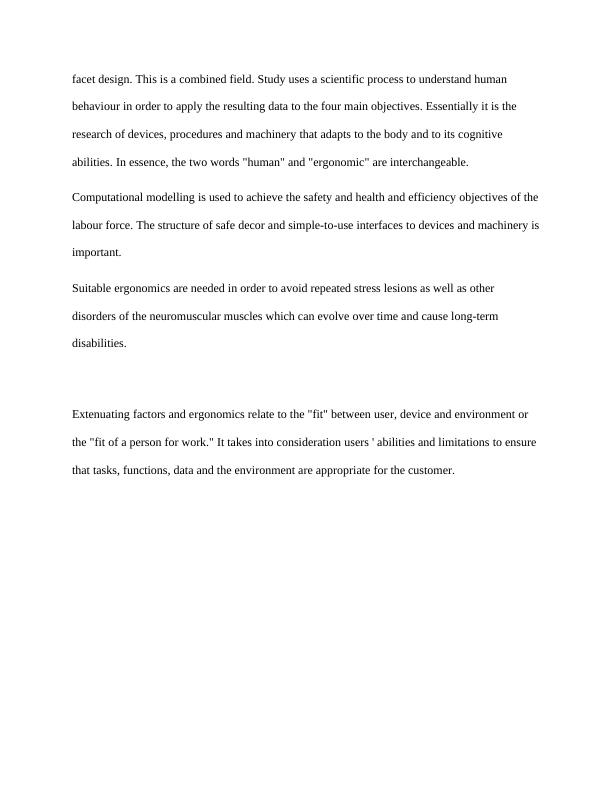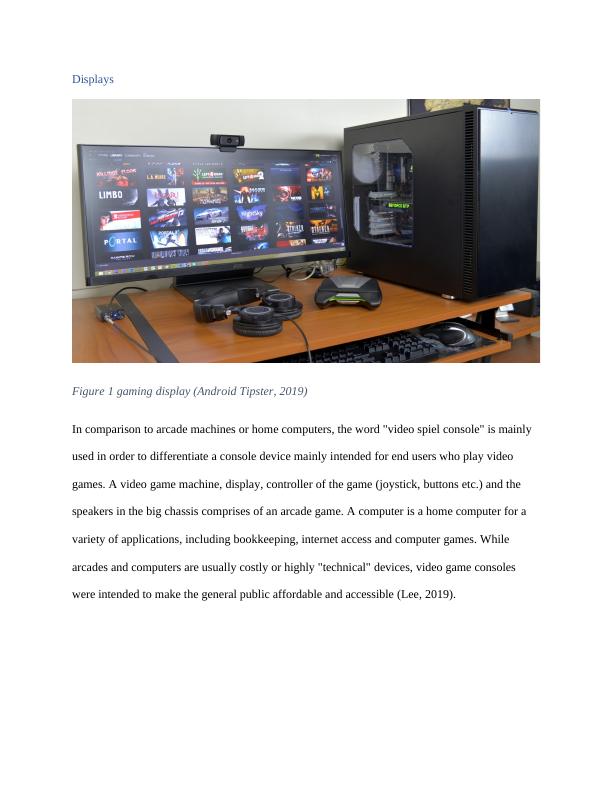Human Ergonomic Factors in Gaming System
21 Pages2809 Words74 Views
Added on 2023-03-17
About This Document
This paper discusses the human factors to consider in designing a gaming system. It covers topics such as perceptual principles, attention principles, gestalt principles, memory principles, mental model principles, controls, anthropometry, and workspace design.
Human Ergonomic Factors in Gaming System
Added on 2023-03-17
ShareRelated Documents
Human Ergonomic factors in Gaming system
Student name
Course title
Lecturer
Institution
Student name
Course title
Lecturer
Institution

Abstract
The role of this paper is to discuss human factors to consider in designing a gaming system. A
good gaming system should meet adequate requirements of comfortability. A gaming console is
a device to display a video signal or visual image for a video game that can be played by one or
even more people.In comparison to arcade machines or home computers, the term ' video game
console' is used mainly for distinguishing between consoles designed primarily for consumers
who play computer games. An arcade device has a video game, a show, a DualShock controller
(stick, buttons, etc.) and large powertrain amplifiers. A computer is a home computer for a
variety of purposes, for example accounting, Internet access and video gambling.
The role of this paper is to discuss human factors to consider in designing a gaming system. A
good gaming system should meet adequate requirements of comfortability. A gaming console is
a device to display a video signal or visual image for a video game that can be played by one or
even more people.In comparison to arcade machines or home computers, the term ' video game
console' is used mainly for distinguishing between consoles designed primarily for consumers
who play computer games. An arcade device has a video game, a show, a DualShock controller
(stick, buttons, etc.) and large powertrain amplifiers. A computer is a home computer for a
variety of purposes, for example accounting, Internet access and video gambling.

Contents
Abstract.......................................................................................................................................................2
Introduction.................................................................................................................................................4
Displays.......................................................................................................................................................5
1. Perceptual Principles.......................................................................................................................6
2. Principles based on attention...........................................................................................................7
3. Gestalts principles............................................................................................................................8
4. Memory principles...........................................................................................................................9
5. Mental model principles................................................................................................................10
Controls.....................................................................................................................................................10
1. Recognition...................................................................................................................................11
2. Response selection.........................................................................................................................11
3. Continuous control and tracking....................................................................................................12
4. Direct and indirect control devices................................................................................................13
5. Non-standard controls....................................................................................................................13
Anthropometry and workspace design.......................................................................................................13
1. Anthropometric table.....................................................................................................................13
2. Link analysis..................................................................................................................................16
3. Spatial organisation of workspace.................................................................................................17
4. Component layout..........................................................................................................................18
5. Analytical analysis.........................................................................................................................18
References.............................................................................................................................................19
Figure 1 gaming display (Android Tipster, 2019)...........................................................................5
Abstract.......................................................................................................................................................2
Introduction.................................................................................................................................................4
Displays.......................................................................................................................................................5
1. Perceptual Principles.......................................................................................................................6
2. Principles based on attention...........................................................................................................7
3. Gestalts principles............................................................................................................................8
4. Memory principles...........................................................................................................................9
5. Mental model principles................................................................................................................10
Controls.....................................................................................................................................................10
1. Recognition...................................................................................................................................11
2. Response selection.........................................................................................................................11
3. Continuous control and tracking....................................................................................................12
4. Direct and indirect control devices................................................................................................13
5. Non-standard controls....................................................................................................................13
Anthropometry and workspace design.......................................................................................................13
1. Anthropometric table.....................................................................................................................13
2. Link analysis..................................................................................................................................16
3. Spatial organisation of workspace.................................................................................................17
4. Component layout..........................................................................................................................18
5. Analytical analysis.........................................................................................................................18
References.............................................................................................................................................19
Figure 1 gaming display (Android Tipster, 2019)...........................................................................5

Figure 2 setting up the display (Android Tipster, 2019).................................................................6
Figure 3 multi display gaming system (Sanchez-Lite et al., 2013).................................................7
Figure 4 gaming joystick patterns (Afonso, 2019)..........................................................................8
Figure 5 sample gaming control (Afonso, 2019).............................................................................9
Figure 6 simple design of a gaming controller (Afonso, 2019).....................................................10
Figure 7 sample gaming posture....................................................................................................12
Figure 8 recommended seating positions parameters during gaming...........................................13
Figure 9 two consideration for standing and sitting gaming positions (Computingcomfort.org,
2019)..............................................................................................................................................14
Figure 10 sample workspace design for average population designed in (Computingcomfort.org,
2019)..............................................................................................................................................15
Introduction
The implementation of psycho-physiological values for the design and (engineering and)
development of products, procedures and structures is human factors and ergonomics (usually
referred to as human factors). The objective of human factors is to control human error, improve
productivity and improve safety, with a special focus on human-interaction. It does not merely
involve changes or modifications to the workplace, but includes ergonomically theory,
techniques, information and values.
The area combines many subjects including sociology, economics, manufacturing, physiology,
design, biomechanics, anthropometry, interaction design, visual style, user interface, and user-
Figure 3 multi display gaming system (Sanchez-Lite et al., 2013).................................................7
Figure 4 gaming joystick patterns (Afonso, 2019)..........................................................................8
Figure 5 sample gaming control (Afonso, 2019).............................................................................9
Figure 6 simple design of a gaming controller (Afonso, 2019).....................................................10
Figure 7 sample gaming posture....................................................................................................12
Figure 8 recommended seating positions parameters during gaming...........................................13
Figure 9 two consideration for standing and sitting gaming positions (Computingcomfort.org,
2019)..............................................................................................................................................14
Figure 10 sample workspace design for average population designed in (Computingcomfort.org,
2019)..............................................................................................................................................15
Introduction
The implementation of psycho-physiological values for the design and (engineering and)
development of products, procedures and structures is human factors and ergonomics (usually
referred to as human factors). The objective of human factors is to control human error, improve
productivity and improve safety, with a special focus on human-interaction. It does not merely
involve changes or modifications to the workplace, but includes ergonomically theory,
techniques, information and values.
The area combines many subjects including sociology, economics, manufacturing, physiology,
design, biomechanics, anthropometry, interaction design, visual style, user interface, and user-

facet design. This is a combined field. Study uses a scientific process to understand human
behaviour in order to apply the resulting data to the four main objectives. Essentially it is the
research of devices, procedures and machinery that adapts to the body and to its cognitive
abilities. In essence, the two words "human" and "ergonomic" are interchangeable.
Computational modelling is used to achieve the safety and health and efficiency objectives of the
labour force. The structure of safe decor and simple-to-use interfaces to devices and machinery is
important.
Suitable ergonomics are needed in order to avoid repeated stress lesions as well as other
disorders of the neuromuscular muscles which can evolve over time and cause long-term
disabilities.
Extenuating factors and ergonomics relate to the "fit" between user, device and environment or
the "fit of a person for work." It takes into consideration users ' abilities and limitations to ensure
that tasks, functions, data and the environment are appropriate for the customer.
behaviour in order to apply the resulting data to the four main objectives. Essentially it is the
research of devices, procedures and machinery that adapts to the body and to its cognitive
abilities. In essence, the two words "human" and "ergonomic" are interchangeable.
Computational modelling is used to achieve the safety and health and efficiency objectives of the
labour force. The structure of safe decor and simple-to-use interfaces to devices and machinery is
important.
Suitable ergonomics are needed in order to avoid repeated stress lesions as well as other
disorders of the neuromuscular muscles which can evolve over time and cause long-term
disabilities.
Extenuating factors and ergonomics relate to the "fit" between user, device and environment or
the "fit of a person for work." It takes into consideration users ' abilities and limitations to ensure
that tasks, functions, data and the environment are appropriate for the customer.

Displays
Figure 1 gaming display (Android Tipster, 2019)
In comparison to arcade machines or home computers, the word "video spiel console" is mainly
used in order to differentiate a console device mainly intended for end users who play video
games. A video game machine, display, controller of the game (joystick, buttons etc.) and the
speakers in the big chassis comprises of an arcade game. A computer is a home computer for a
variety of applications, including bookkeeping, internet access and computer games. While
arcades and computers are usually costly or highly "technical" devices, video game consoles
were intended to make the general public affordable and accessible (Lee, 2019).
Figure 1 gaming display (Android Tipster, 2019)
In comparison to arcade machines or home computers, the word "video spiel console" is mainly
used in order to differentiate a console device mainly intended for end users who play video
games. A video game machine, display, controller of the game (joystick, buttons etc.) and the
speakers in the big chassis comprises of an arcade game. A computer is a home computer for a
variety of applications, including bookkeeping, internet access and computer games. While
arcades and computers are usually costly or highly "technical" devices, video game consoles
were intended to make the general public affordable and accessible (Lee, 2019).

End of preview
Want to access all the pages? Upload your documents or become a member.
